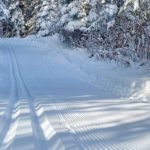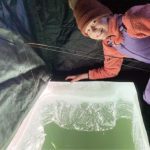Last winter, my girls and I skied in to Found Lake in the Boundary Waters Canoe Area Wilderness just before dusk. It had been a gentle, two-hour trek on a balmy, still day from the Moose Lake entry point. I enjoyed pulling our pulk full of all kinds of winter camping equipment like a woodstove, ice-fishing shelter and calorie-rich food. The girls too were soaking up the sun as they quietly glided over hard-packed lakes. I was looking forward to showing them the sled dog teams we were bound to see the following day heading north to Basswood Lake. Spirits were high. Upon arrival at Found, we discovered that the lone campsite was already taken by other intrepid campers. No matter—in winter you can pitch your tent directly on the frozen lake. Then, just as we started pulling the tent out of its bag, the magic began above: a full-on northern lights eruption exploded in the sky and lasted for the next four hours. We erected our tent under dancing pillars of yellow, purple, green and pink. Winter camping can be that good.
You can’t count on northern lights the first time you try winter camping, but the long, dark nights increase your odds. And there are other facets that make winter camping worth the trek, even if the sky doesn’t transport you to heaven.
First off, pulling your gear in a pulk—a sled attached to your waistbelt or harness by ropes or poles—is surprisingly easy. A long sled allows you to bring more gear, which can be essential for keeping warm in winter. You can pull the pulk on foot, snowshoes or skis. You’ll be impressed how deep into the wilderness you can get, but avoid planning routes over steep portages, as that’s when the pulk is likely to tip over (abundant bungee cords can hold everything in place). Pulks can be rented from local outfitters in Tofte or Grand Marais, or from Outdoor Pursuit programs of colleges in Duluth. Skipulk.com is a Minnesota company with great retail options too, as well as DIY instructions.

Next, if you like making campfires, winter camping is for you. I have friends who can spend all day at camp tending the fire. We’ve also been on BWCAW trips where the snow was so deep, we couldn’t find the buried fire pit; always bring a small shovel to dig it out. Good, dead wood is typically easy to find in winter, and there is no forest fire danger. Foraging and processing wood with a small saw or hatchet is rewarding. Embrace your primitive side and make fire one of your survival tools.
Thirdly, if you love to eat, winter camping encourages gluttony. There is practically no limit to how many calories you can enjoy when camping in the winter. A friend of mine always brings frozen ice cream sandwiches in his pulk and eats them any time of the day. Every step you take will require breaking through snow. Your heavy clothing makes moving your body hard work. And you’ll likely be shivering to some degree all 24 hours of the day (bring two sleeping bags and put one inside the other for a warmer night’s sleep). This constant exertion requires you to increase your intake of calories from carbs, fats and proteins. Indulge in all three to stay warm.
My favorite part of all is the problem-solving that living on snow and ice entails. Yes, winter camping is challenging because the cold and darkness reign supreme. You have to adapt to these conditions by letting the snow and ice help—not harm—you. Many modern technologies don’t work well in the cold, but going back to low-tech methods can bring a great sense of satisfaction. Use an auger to access water straight out of the lake (boil it and make hot drinks frequently). Build a quinzhee shelter—shovel a pile of snow large enough for several people to fit inside, then hollow it out after it settles—and let its thick walls make a mockery of any chilling winds. Traverse frozen swamps and wetlands that you could never dream of portaging to in summer. There are many opportunities that only winter travel can provide. Leaving the mosquitoes and the summer crowds behind are two more selling points for camping in the cold.
Sure, winter camping is something most people wouldn’t consider. Keeping your composure and a positive attitude are more difficult in freezing cold. Build your confidence beforehand through practice and preparation. Set up your tent with cold fingers in the backyard. Sleep for a night in the tent close to home, and use two full-length sleeping pads per person. Cook a meal on your camp stove on a very cold day.
A good winter camping trip is about more than just surviving. The intrigue is using your problem-solving skills to rediscover how you can fit into nature in its frozen form. Give it a shot and embrace the challenge. Nature will reward you—you might even spend the night under the Aurora.




